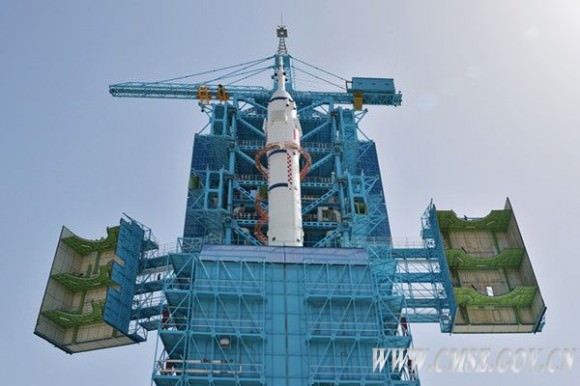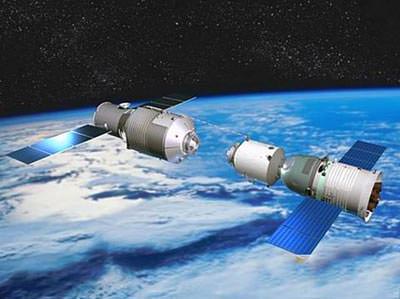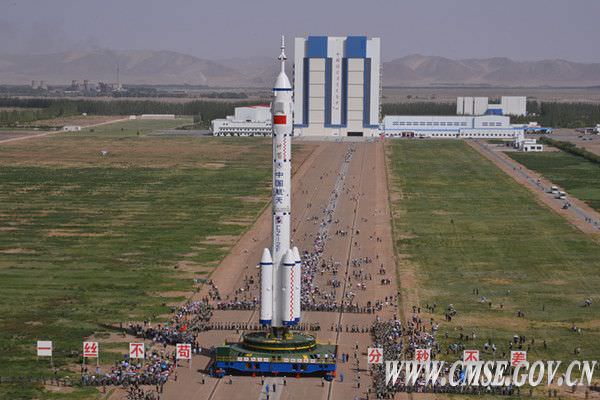Riding atop a fiery Long March rocket, three taikonauts blasted off from Earth today (June 11) to kick off an expected 15-day mission in space that will include the first Chinese “space class” from orbit.
Shenzhou 10 departed the Jiuquan Satellite Launch Center at 5:38 a.m. EDT (9:38 a.m. UTC), or 5:38 p.m. local time at the complex’s location in the Gobi desert. Aboard the spacecraft were one woman (Wang Yaping) and two men (Nie Haisheng and Zhang Xiaoguang). Their next destination is the Chinese Tiangong-1 station.
China has a young manned space program. The first spaceflight with people was just a decade ago, in October 2003, and this is the fifth crewed mission since that time.
While China’s government keeps its long-term ambitions fairly private, observers in the United States and China point to its robotic moon missions as evidence that China is considering a manned lunar mission in the coming decades.
Shenzhou 10’s ultimate destination, however, is the Earth-orbiting, nine-ton Tiangong-1. Like the early U.S. and Soviet space stations, the Chinese one is fairly small (a single module) and serves as an experimental testbed for space station work. Taikonauts also visited the space station during Shenzhou 9 in 2012.
The taikonauts have four main ambitions during the Shenzhou 10 mission, the China Manned Space Engineering government office stated:
– Launch crew and cargo aboard Shenzhou 10 and verify rendezvous and docking technology for the meeting with Tiangong-1;
– Further test Tiangong-1’s capabilities to support humans;

– Conduct several experiments (focusing on space adaptability, space operation ergonomics and unspecified space science work), perform maintenance and do a “space class” with students;
– To see how well the CMSE is performing on a systems basis.
“To further improve the safety, reliability and to be suitable for the specific requirements of this mission,” stated spokesperson Wu Ping, “partial technical alterations have been made in [the] Shenzhou 10 spaceship and Long March 2F Y10 rocket.
“During this mission,” she added, “taikonauts will change and repair some of the equipment and facilities in Tiangong-1 through on-orbit operations.”
In the first few hours after launch, the CMSE stated that all systems are performing normally.
“The Shenzhou 10 spaceship has accurately entered its orbit and the crew members [are] in good condition,” stated Zhang Youxia, chief commander of China’s manned space program.
The mission drew praise from China’s president, Xi Jinping, who sent the crew good wishes just before they left Earth.

“You have made Chinese people feel proud of ourselves,” Xi told the crew, according to a BBC report.
“You have trained and prepared yourselves carefully and thoroughly, so I am confident in your completing the mission successfully. I wish you success and look forward to your triumphant return.”
China ultimately plans to launch a larger space station sometime around 2020, which would include several modules.
The European Space Agency is considering working more closely with China around that time, the BBC added, and some astronauts have already starting Chinese language training.


I don’t believe in China so much. I’ll wait and see what can they do
china don’t need your believe to become super power.
Way to go China.
One big advantage China has, they can put more people in the same capsule. 🙂
A ‘Long March’ indeed… there are many steps on the way to the stars! Good luck and god speed~
Nice that ESA and CMSE is still collaborating on this. It may mean that we will continue to have an international space station of sorts when the ISS is retired.
Is it just me or does this look a lot like a copy of the VAB and Launch Complex 39 at the Cape????